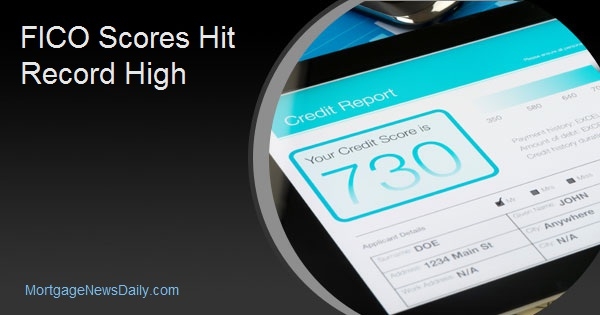Lesson learned? Whether they saw their credit decimated by the housing crisis and the Great Recession or merely watched loan standards tightened beyond their ability to qualify, Americans seem to have taken to heart the importance of their credit scores. The result, FICO says, is that consumer credit scores have reached a new high, an average of 704 points.
Kenneth Harney, in an article for the Washington Post's Writers' Group, quotes FICO Vice President of Scores and Analytics Ethan Dornhelm that Americans are "making more judicious use of credit." This means higher scores on the FICO model that weights them not only in terms of on-time payments but on the length of the credit history, the amount and type of credit a consumer has available, and how much of that available credit is being used.
The 704 point average score, on scale that runs from 300 to 850, is a substantial improvement from the average of 686 in 2009. Harney points out that a lot of the improvement, 5 points, has been added in the last two years, one of the fastest two-year runups in FICO history.
A score of 704 is considered good, meaning a consumer is a fairly safe bet for performing on a loan as agreed, and usually gets that borrower a fairly good interest rates and other terms. The best deals are usually reserved for those with scores of 750 or better. However, while FICO scores for most categories of borrowers are rising, Harney points out that the averages for people taking out mortgages are sliding, down from 745 in the years after the crash to about 733. This, of course, is not a reflection on borrowers but rather an indication that mortgage lenders are relaxing their standards, accepting slightly lower scores in their underwriting.
There are variations in average scores by age. Persons 18 to 29, a range that includes some Millennials and most adults of Generation Z, have an average score of 659. They will typically have not only credit histories but thinner credit files, many any negative report will weigh more heavily on the score. The average score for people ages 40 to 49 is 690, and for those 60 and older, it's 747.
There are a lot of factors that help account for the overall higher scores. First, fewer people have truly awful ones. Those with scores under 500 now constitute 4.2 percent of the total, down from 7.3 percent in 2009 and the share with scores from 500 to 549 has dropped from 8.7 percent to 6.8 percent.
On the other end of the spectrum, 22 percent of those with a FICO number are considered "super-scorers," with a score over 800. Forty-two percent have scores between 750 and 850.
Some help may have come from a change in reporting by the three major credit bureaus that we noted a few weeks ago. So-called collection reports, defaulted accounts that are sold to a third-party, have been handled differently since the first of this year. They must be associated with a contract or agreement to pay and marked as paid when they are. Medical accounts have to be at least 180 days past due before being reported and all collection accounts must have sufficient information to link them to that consumer. The number of credit files with collection accounts were reported by the Federal Reserve as dropping from 12 percent last year to 9 percent at present.
Dornhelm says that lessons from the housing crisis are clearly affecting scores and consumer behavior. He thinks more Americans have access to and better understand their credit scores and how to manage them, including managing the amount of their debt.







